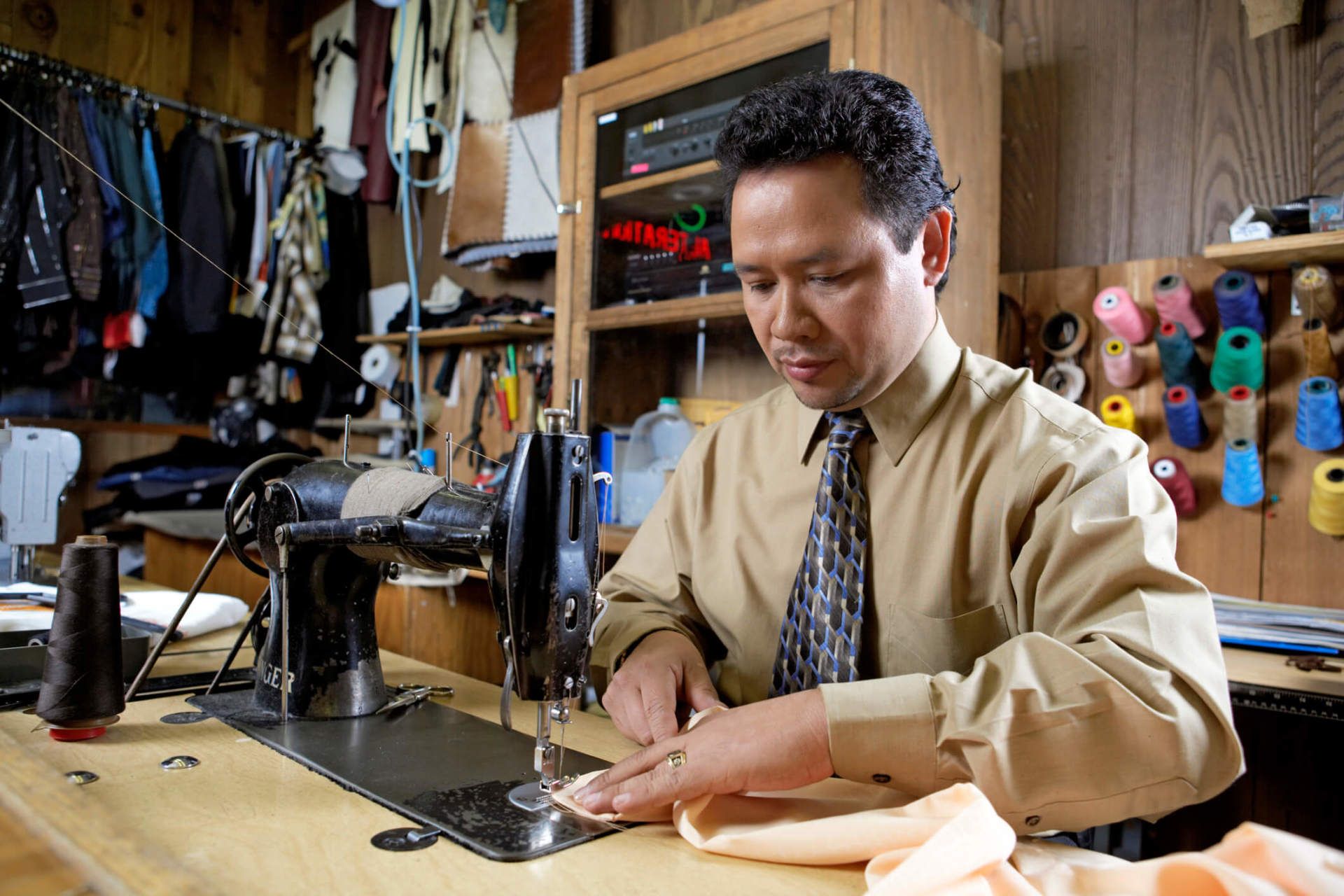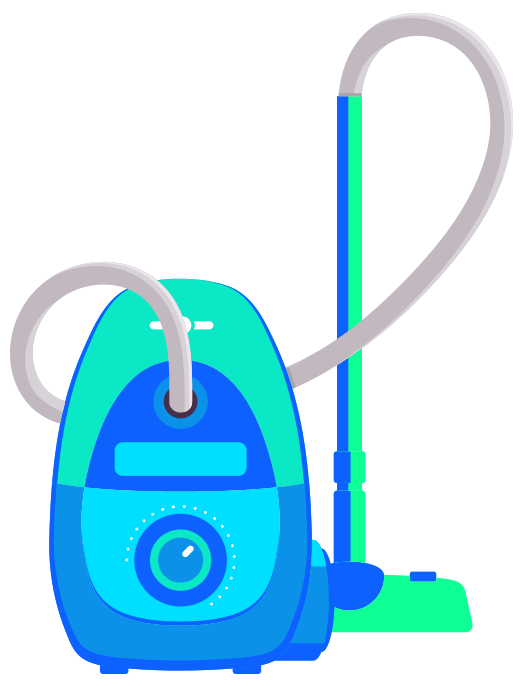Sewing Helpful Hints from Neverett's Sew and Vac Inc. in Nashua, NH
Read your instruction manual carefully while sitting at your machine to familiarize yourself with each feature and part. Try to memorize the various knobs and or controls illustrated in the manual because various references are made to them throughout the manual in preparation of particular stitches. Once you understand the basic operation of a sewing machine you will see how easy it is to sew beautifully.
The most common stitch made by the household sewing machine is called the lock stitch. This requires two threads, one threaded on the top of the sewing machine and one threaded on the bottom of sewing machine. When the sewing machine tensions are correct. The knot tied by the sewing machine will be in the middle of the fabric. From this basic stitch, many variations of stitching can be performed such as zigzag, buttonholes, blind stitch, overcasting, embroidery, etc. The variety of stitches depends upon the model or type of sewing machine you may have.
Before you begin to sew, select the proper thread and needle for the fabric you want to sew. Most sewing machine manufacturers install a number 14 needle in new sewing machines which is recommended for sewing with 60 to 80 cotton or 50 mercerized thread. In any case always make sure your sewing needle has a good sharp, straight needle. Bent or dull sewing machine needles will cause thread breakage.
Before you begin to sew, select the proper thread and needle for the fabric you want to sew. Most sewing machine manufacturers install a number 14 needle in new sewing machines which is recommended for sewing with 60 to 80 cotton or 50 mercerized thread. In any case always make sure your sewing needle has a good sharp, straight needle. Bent or dull sewing machine needles will cause thread breakage.

Wind a bobbin and place the bobbin thread in position according to the instructions listed in your instruction book. Always be sure the bobbin case (bottom thread) is securely locked in position, otherwise it may fall out of position when you start to sew. Allow an excess of 3 to 4 inches of thread to dangle free to permit the needle to pick up the thread. Now top thread your machine

Now top thread your machine following the instructions illustrated in your manual. Proper threading is extremely important. Improper threading will cause the sewing machine to skip stitches, break thread, sew loosely, etc.
After both top and bottom thread are in the machine hold a few inches of top thread in your left hand and turn the hand wheel with your right hand. Make one complete turn to lower and raise the needle. This action will pick up the bottom thread. Now place both top and bottom threads under and behind the presser foot (ft). You are now ready to sew. Try practicing on scrap material first, but do not practice on a single thickness. Always use two or more or the stitch will not look normal. Never tug on the fabric as you sew. Not only is it unnecessary since the sewing machine will move the material, but the tugging may bend or break the needle.
After both top and bottom thread are in the machine hold a few inches of top thread in your left hand and turn the hand wheel with your right hand. Make one complete turn to lower and raise the needle. This action will pick up the bottom thread. Now place both top and bottom threads under and behind the presser foot (ft). You are now ready to sew. Try practicing on scrap material first, but do not practice on a single thickness. Always use two or more or the stitch will not look normal. Never tug on the fabric as you sew. Not only is it unnecessary since the sewing machine will move the material, but the tugging may bend or break the needle.
When you begin to sew, turn the hand wheel by hand until the point of the needle begins to penetrate the cloth. Lower the presser foot onto the material. Now you're ready to apply the power. When you remove the material from the sewing machine, lift the presser foot all the way up and pull the material away from you, not toward you. Always leaving 3 to 4 inches of new thread to begin sewing again. Try doing these things as a matter of habit. You'll find that it will help you sew faster and easier.
Never run the sewing machine without fabric under the presser foot. This can cause threads to become caught in the stitching mechanism. As a result, the machine may begin to turn hard or not turn at all until the lower section is cleaned of loose thread.
To turn corners easily, stop the sewing machine while the needle is in the material. Raise the presser foot and turn the fabric, using the needle as a pivot. Then lower the presser foot and resume sewing.
Tension settings seldom need changing because both top and bottom tensions are pre-set at the factory. Should you find it necessary to change the tension slightly for basting, shirring, heavy material, etc. Always remember to return the dial to its normal position. Don't change the settings if the sewing machine is missing stitches (skipping). First check to see if the sewing machine is properly threaded or if needle is bent or blunt. Bent or blunt needles will cause thread breakage.
Always turn the hand wheel toward you. If the sewing machine is threaded and you inadvertently turn the hand wheel backward, the thread will break. Bear in mind that the machine continues to turn forward even wheel you sew in reverse.
Like any equipment that has moving parts, your sewing machine should be oiled occasionally. How often you oil your sewing machine depends upon the amount of sewing you do. Check your instruction manual for oiling instructions on your machine. Your manual will probably say that you should oil you sewing machine after about 8 hours of use. Caution, do not oil electronic parts or computer sewing machines. Electronic and computer sewing machines should be oiled only by sewing machine technicians. Electronic and computer sewing machines do not need to be oiled as often (see your instruction manual).
Never run the sewing machine without fabric under the presser foot. This can cause threads to become caught in the stitching mechanism. As a result, the machine may begin to turn hard or not turn at all until the lower section is cleaned of loose thread.
To turn corners easily, stop the sewing machine while the needle is in the material. Raise the presser foot and turn the fabric, using the needle as a pivot. Then lower the presser foot and resume sewing.
Tension settings seldom need changing because both top and bottom tensions are pre-set at the factory. Should you find it necessary to change the tension slightly for basting, shirring, heavy material, etc. Always remember to return the dial to its normal position. Don't change the settings if the sewing machine is missing stitches (skipping). First check to see if the sewing machine is properly threaded or if needle is bent or blunt. Bent or blunt needles will cause thread breakage.
Always turn the hand wheel toward you. If the sewing machine is threaded and you inadvertently turn the hand wheel backward, the thread will break. Bear in mind that the machine continues to turn forward even wheel you sew in reverse.
Like any equipment that has moving parts, your sewing machine should be oiled occasionally. How often you oil your sewing machine depends upon the amount of sewing you do. Check your instruction manual for oiling instructions on your machine. Your manual will probably say that you should oil you sewing machine after about 8 hours of use. Caution, do not oil electronic parts or computer sewing machines. Electronic and computer sewing machines should be oiled only by sewing machine technicians. Electronic and computer sewing machines do not need to be oiled as often (see your instruction manual).
